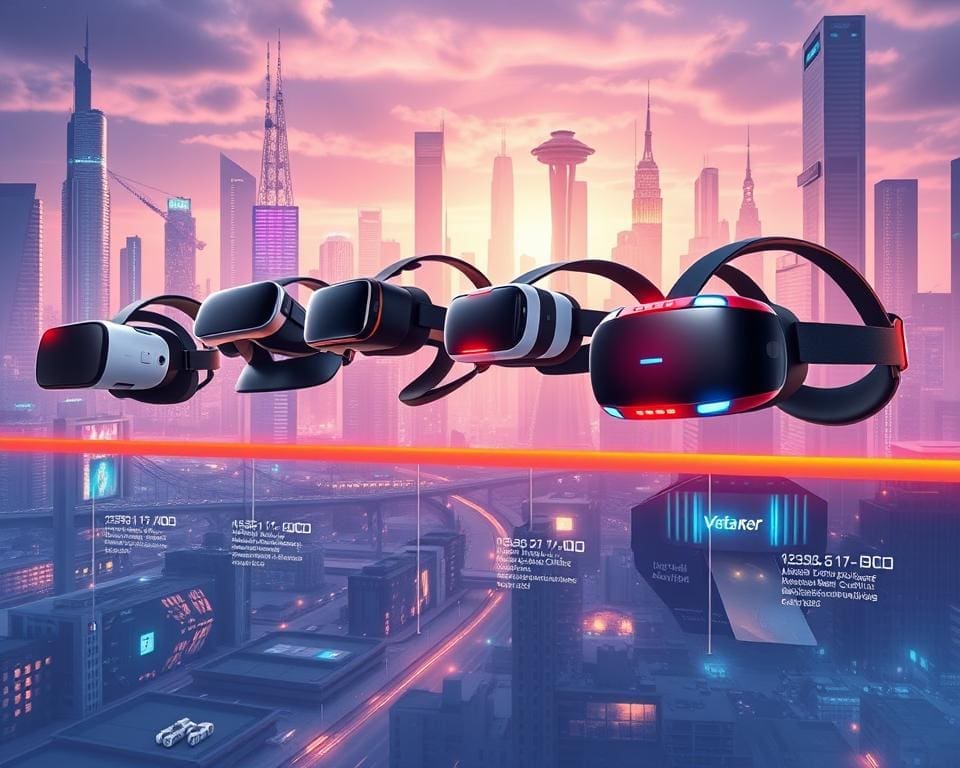As technology rapidly advances, Virtual Reality Headsets are emerging as a revolutionary element of Gaming Technology, transporting players into realms where the lines between reality and the digital world blur. This new era of immersive experience enables gamers to interact with their surroundings in ways previously thought impossible, creating profound engagement with the virtual environments they explore.
Market research from sources like Statista and the International Data Corporation indicates a robust growth trajectory in the adoption of these headsets. This expansion invites both gamers and developers to embrace the transformative potential of virtual reality, suggesting not just a new way to play, but an entirely new avenue for creative possibilities. As we journey through this section, let us delve into how Virtual Reality Headsets are indeed setting the stage for the future of gaming.
The Evolution of Virtual Reality Headsets
The journey of virtual reality headsets has been a fascinating blend of innovation and creativity, tracing a path from initial concepts to widely accepted devices. As interest burgeoned, the Evolution of Virtual Reality blossomed into a defining era for gaming technology. Understanding this movement allows for a deeper appreciation of the immersive experiences available today.
From Concept to Reality
The narrative begins with imaginative ideas from the 1950s, where pioneers like Morton Heilig conceptualised immersive experiences through inventions like the Sensorama. This early work laid the groundwork for subsequent advancements, paving the way for companies such as Oculus and HTC to redefine virtual reality. The process of Virtual Reality Development has transformed theoretical notions into practical applications accessible to gamers worldwide.
The Role of Early VR Technology
Early VR technology played a crucial role in establishing the framework for modern advancements. The transition from bulky equipment to sleek headsets demonstrates the continuous evolution undertaken by manufacturers. Notable milestones include the launch of devices such as Sony’s PlayStation VR in 2016, showcasing the immense strides made since those first experimental setups. The impact of these early innovations cannot be overstated, shaping the current landscape of immersive gaming through relentless determination and creativity.

Understanding Immersive Experiences
In the realm of gaming, immersion stands as a critical component that shapes player experiences. The shift from traditional formats to Virtual Reality Gaming engages players in a manner that transforms how they interact with the game world. This evolution not only enhances the emotional depth of gameplay but also fosters deeper connections between players and their environments.
How Immersion Transforms Gaming
The concept of an *Immersive Gaming Experience* transcends mere visuals and sound. Virtual Reality enables players to feel as if they are truly part of the game. This sensation, known as presence, allows users to engage with their surroundings more deeply than ever before. The immersive qualities of VR can evoke genuine emotional responses, resulting in a gaming experience that lingers long after gameplay ends.
Comparing Traditional Gaming Versus VR Gaming
A Traditional Gaming Comparison reveals fascinating insights. While conventional games can provide enjoyment, they often involve a passive form of engagement, where players observe rather than participate actively. In contrast, Virtual Reality Gaming immerses players completely, enabling them to influence and interact with their environments dynamically. Research illustrates that users experience higher levels of satisfaction and emotional investment during VR sessions, highlighting a clear distinction in engagement levels.
Virtual Reality Headsets: Gaming’s Next Frontier
The landscape of virtual reality is expanding rapidly, offering gamers an unprecedented opportunity to immerse themselves in fantastical worlds. When exploring the best VR headsets available today, a few models consistently rise to the top of reviews. These devices not only showcase advanced technology but also enhance the overall experience for users.
The Best VR Headsets on the Market
Currently, the Oculus Quest 2, Valve Index, and HTC Vive Pro are among the best VR headsets that cater to a diverse range of gaming preferences. Each of these headsets boasts unique attributes and VR hardware features that attract different audiences:
- Oculus Quest 2: Known for its standalone capabilities and affordability, it offers an impressive resolution and a large library of compatible games.
- Valve Index: This high-end option features precise motion tracking and high-quality visuals, appealing to enthusiasts seeking a more refined experience.
- HTC Vive Pro: Designed for comfort and professional use, it provides exceptional audio and visual fidelity, making it ideal for serious gamers.
What to Look for When Choosing a Headset
When choosing a VR headset, potential buyers should consider several key factors to ensure they select a model that meets their needs. These include:
- Resolution: Higher resolution leads to better clarity, enhancing immersion.
- Field of View: A wider field of view creates a more realistic experience by allowing users to take in more of their virtual surroundings.
- Motion Tracking: This feature is crucial for accurate and responsive gameplay, affecting overall immersion.
- User Comfort: The weight and ergonomics of a headset play a significant role, especially during extended gaming sessions.
Researching tech review sites such as TechRadar and CNET can offer valuable insights into these considerations, guiding individuals through the selection process while ensuring they choose the best VR headset to enrich their gaming adventures.
Impact of 3D Audio Technology in VR
In the realm of virtual reality, the integration of 3D Audio Technology has emerged as a transformative force, significantly enhancing the player’s experience. As technology advances, sound becomes not just an additive element but a fundamental aspect of immersion, contributing to the overall sensation of being part of the virtual world.
Creating a Realistic Soundscape
The development of Realistic Soundscapes is pivotal in crafting engaging virtual environments. Through meticulous sound design, game developers create an audio landscape that envelops the player, making every footstep and whisper resonate authentically. Titles such as Half-Life: Alyx exemplify how advanced sound techniques can transport players into richly woven audio experiences, aligning perfectly with the visual stimuli.
The Importance of Spatial Awareness in Games
Spatial Awareness in VR is enhanced significantly by the accurate placement of sounds. When players perceive direction and distance through sound, their interaction with the game world deepens. As they turn their heads or shift positions, dynamic audio cues respond in real-time, fostering a sense of realism. This interplay between sound and vision enriches the gaming experience, ensuring that every encounter feels genuine and impactful.
Integrating Augmented Reality with VR
The intersection of Augmented Reality Integration and Virtual Reality technology heralds a remarkable era in gaming. Innovations are changing the way players engage with both digital and physical environments, creating immersive experiences that were once mere dreams. As the lines between reality and fantasy blur, the Future Gaming Technology landscape is evolving rapidly.
The Future of Gaming Technology
With advancements constantly emerging, the potential of combining AR and VR is vast. Cutting-edge platforms are now capable of delivering mixed-reality experiences. These experiences let players virtually overlay digital elements onto real-world scenarios, enhancing interactivity and engagement. Popular applications like Pokémon GO exemplify the successful fusion of augmented reality in gaming, captivating users with its interactive gameplay.
Real-World Applications Beyond Gaming
The integration of VR Applications stretches beyond entertainment. Industries such as education, healthcare, and retail are beginning to adopt these immersive technologies. Training simulations allow healthcare professionals to practice procedures in a safe, virtual environment. Retailers are enhancing customer experiences by enabling users to visualise products in their actual spaces before purchasing.
The Future of Virtual Reality Hardware
The landscape of virtual reality is continuously evolving, with significant advancements leading the way towards a more immersive and accessible experience. As technology progresses, the integration of holographic displays and wireless, lightweight VR models becomes increasingly vital for enhancing user engagement.
Advancements in Holographic Displays
Current innovations in holographic displays are positioned to redefine how users interact with virtual environments. These displays offer vibrant visuals that enhance realism, creating a captivating experience. Companies like Microsoft are spearheading the development of these technologies, allowing for more nuanced and detailed simulations, especially in gaming and training applications.
Exploring Wireless and Lightweight Models
The shift towards wireless connectivity in VR hardware reflects a desire for enhanced mobility and convenience. Lightweight VR models are emerging as a response to the need for comfortable, prolonged use without compromising performance. These advancements significantly increase accessibility, allowing a broader audience to engage with the future of VR hardware seamlessly.
The Community and Culture of VR Gaming
The emergence of the VR gaming community represents a significant shift in how players connect and interact. Unlike traditional gaming networks, the unique immersive environments of VR foster rich, social interaction in VR that allows individuals to forge meaningful relationships, regardless of geographical boundaries. Platforms like VRChat offer players not only a space to game but also a vibrant social arena where shared experiences cultivate a robust gaming culture.
Sociological studies have shown that virtual interactions can mirror, and at times surpass, real-world connections, creating profound bonds among users. Reports from developers reveal that players often report an enhanced sense of belonging within the VR gaming community. This phenomenon speaks to a larger trend where individuals find solace and companionship amid the digital landscape, transforming isolated gaming sessions into communal experiences.
The culture surrounding VR gaming is also marked by creative expressions and collaborative gameplay. Participants engage in various multiplayer VR games, demonstrating how collective challenges foster teamwork and camaraderie. As the technology evolves, so too does the culture, reflecting the dynamism of a community continually redefining the nature of gaming and social interaction within these immersive worlds.









